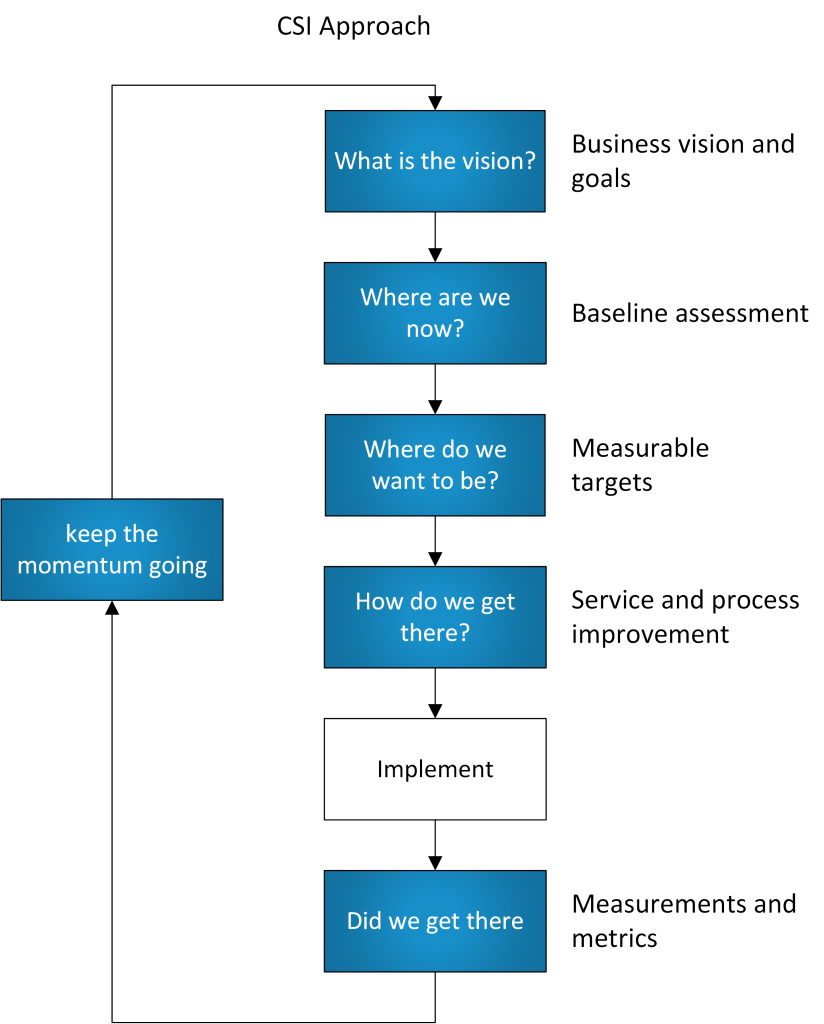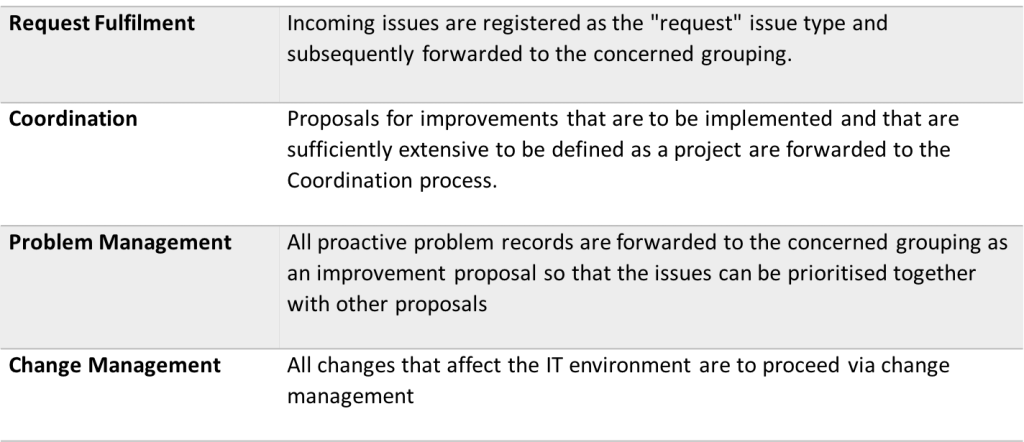Most IT organizations have a culture of continually improving their IT environment and their working method. The problem is that too many changes take place simultaneously and that they take place independently of each other. They are often initiated at operational level, which means that the activities can take place without knowledge at tactical level or coordination. There is thus a major risk of duplicating work or, in the worst case, parallel activities which directly counteract with each other.
Continual Service Improvement consists of a method which should be used by the IT organization when making improvements, and also a process to coordinate and prioritize which activities are the most important to implement.

Purpose
The purpose of Continual Service Improvement is to constantly improve the quality and efficiency in production of IT services so that they can meet the business’s needs. This entails both achieving and exceeding the objectives that are set (quality) and also achieving these objectives at the lowest possible cost (efficiency). The IT organization can increase quality through, for example, reducing the number of errors in a process. A process can be made more efficient through eliminating unnecessary activities or alternatively by automating manual operations.
Activities to achieve the aim of Continual Service Improvement are:
- Measuring and analyzing service levels through comparing them with the requirements in the agreements (SLA)
- Coordinating and performing activities that will increase the quality, efficiency, and customer satisfaction of IT services
- Coordinating and controlling methods for improvement measures and quality control within the IT organization as a whole
Scope
Continuous Service Improvement comprises the entire IT organization, including all functions, services, processes and procedures. The objective is to have control over all improvement proposals in order to subsequently be able to prioritize and implement improvements where the IT organization can achieve the best effect with a reasonable input at the time.
Value for the business
Continual Service Improvement enables the business to obtain the best possible quality in the delivery of IT services at all times.
Continual Service Improvement creates:
- Clarity in how the IT organization should prioritize its resources
- A structured working method for managing improvement proposals
- Increased focus on improving the delivery of IT services
- Increased efficiency in all parts of the IT organization
Continual Service Improvement approach
The aim of the approach is to divide overall objectives into manageable and defined steps. If each step then is guided towards the overall objective, it will ultimately be achieved. For the approach to function it requires that the IT Steering Group define the overall objectives at strategic level. If these are not in place, it is impossible to indicate the direction for each step at a tactical and operational level.
If the purpose of an improvement is not understood, it only has a limited value. The IT organization is then putting resources into an activity which runs the risk of not achieving full effect, or in the worst case, counteracting the overall planning.
The approach consists of seven steps:
What is the vision? – The IT Steering Group has an insight into the objectives for the business, and together with the business formulates a vision and an IT strategy linked to the operational strategy. Based on this, assignments, objectives and aims are formulated for the IT organization. Each improvement activity should be linked to these objectives and formulated in such a way as to set out how the activity contributes to the objective.
Where are we now? – Measure and document the starting point for the improvement. This starting point is called baseline and functions as a reference value for the forthcoming measurement when the improvement activity is completed.
Where do we want to be? – Establish measurable objectives for the improvement activity which are in line with the overall objectives for the IT organization.
How do we get there? – Prepare a detailed improvement plan consisting of activities to achieve the objectives.
Implement – Implement the activity/project according to the plan.
Did we get there? – Measure whether the objectives have been achieved, check that the IT organization has accepted the change and that is has become a natural part of the work.
Keep the momentum going – Continue to measure and follow up the change on an ongoing basis in order to ensure that the change remains in place and becomes a new baseline prior to the forthcoming improvement initiative.

Activities in the process
The process in Continual Service Improvement has the aim of collecting up proposals and prioritizing which step is the most suitable based on the current situation, in order to subsequently implement and follow up the change.
Registration and categorization – Anybody within the IT organization can register a proposal for improvement. Issues are registered as a proposal within the Request Fulfilment process, which then becomes the categorization which governs which grouping has responsibility for the issue.
Analysis and supplementation – When issues come in, they have to be analyzed and if necessary supplemented with information from the person who has registered the issue. In certain cases, a minor investigation may also be required before the issues can be taken up for prioritization at the improvement meeting.
Prioritization – Issues received are prioritized together with old issues that have not been executed, as well as issues that have been escalated from the Problem Management process for a decision on continued investigation. The aim of having all active issues as part of the same prioritization is to create a comprehensive view and put resources into the issues that will provided optimum return. The prioritization is best implemented as a separate item on the agenda at a regular meeting of the grouping.
Implement improvement – Implement the improvement in accordance with the improvement method.
Evaluation and close – Ensuring that Continual Service Improvement has an effect within the IT organization requires all improvement issues to go via the process and be prioritized together with everything else. It is not just completed activities that are analyzed during the evaluation, but also the overall management of improvement proposals.

Measurement
Continual Service Improvement requires continual measurement of a number of different parameters. Before improvement activities commence, a baseline is needed as a starting point, and after activities have been implemented, ongoing measurements are required to confirm the change. An aspect of setting numerical values is to reflect on why the measurement is being performed.
There are four fundamental reasons:
To validate – Measurement to confirm an improvement or decision that has been implemented.
To direct – Measurement to control a behavior or activity with the aim of achieving an objective. This is the most commonly occurring type of measurement.
To justify – Measurement to certify or prove that something needs to be rectified.
To intervene – Measurement to identify a point for intervention. This type of measurement is common in connection with monitoring a system or infrastructure together with directly corrective measures.
Measuring in order to provide control is a challenge, and the phenomenon “you get what you measure” exists in all organizations. People want to be appreciated, and if a particular kind of behavior is rewarded, then the organization will ultimately display that behavior. If the numerical values are not then clearly linked to the overall objectives for the IT organization, the measurement can directly counteract the overall efficiency.
Besides a clear connection to overall objectives, each measurement should be conducted on the basis of two perspectives, efficiency and quality. Efficiency is how quickly an activity is performed and quality is the precision with which the objective is achieved, i.e. how good the IT organization is at doing things correctly.
Examples: If the Service Desk function is measured on the basis of the number of calls per employee, the staff will become very efficient in handling calls. However, the risk is that Service Desk staff will finish calls before ensuring that the caller has really received help with his/her issue, with the consequence that the quality is impaired. To regulate the balance between quality and efficiency, the efficiency measurement, ”number of calls per employee”, should be supplemented with a quality measurement such as, ”solution provided in first call”.
Each measurement that has the aim of controlling an organization consequently takes place in two dimensions, efficiency and quality. If we only measure one, we run the risk of creating an organization which becomes very good at doing the wrong things.
Documentation
The following documentation should be available within the framework of Continual Service Improvement:
- Priority list of proposed improvements that have been received
- Work procedures for the improvement method
- Method for measurement
Relationships with other processes and functions
Continual Service Improvement has links with many other processes. The most common are listed here:

Trigger
Continual Service Improvement is triggered through one of the following:
- A proposal for improvement is registered
- A proactive problem is defined
- New or changed objectives set at strategic level
- Measurement of quality and efficiency revealing that the objectives have not been achieved
Input
The following inputs are needed for Continual Service Improvement:
- Strategic overall objectives for the IT organization
- Relevant agreements with the business
- Contractual documentation for suppliers
- Documentation of IT services
Output
The following outputs are generated by Continual Service Improvement:
- Improvement activities implemented
- A priority list of proposed improvements
Measurement of the process
Measurement of Continual Service Improvement can be performed as follows:
- Number of registered proposals for improvement
- Number of improvement activities implemented
- Proportion of improvement activities implemented which deliver the proposed effect
- Proportion of IT services and supporting services which have a defined baseline
Challenges
The following elements need specific attention when implementing Continual Service Improvement:
- Dividing up major improvement proposals into more concrete activities
- Finding the right allocation of responsibilities, especially if no service structure is in place
- Structuring the collaboration with Problem Management for proactive problems
- That coordinating implementation of activities really takes place via coordination

